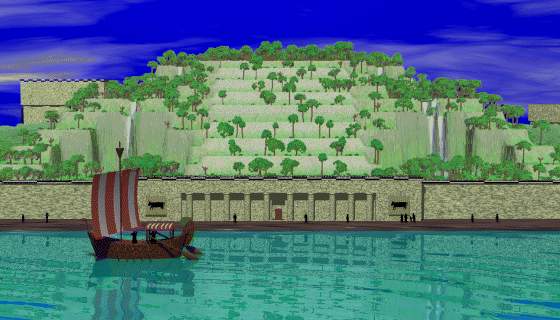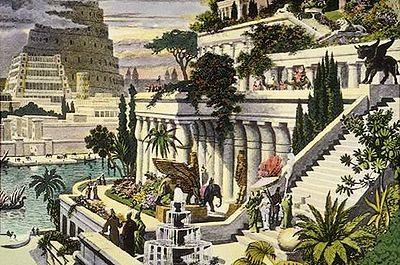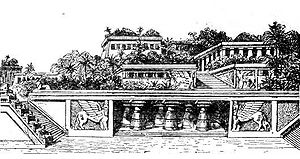|
Click on the names of the cities THE HANGING GARDENS
The Hanging Gardens of Babylon are perhaps the most mysterious of the seven wonders. They are remarkable in that they compose the only wonder whose very existence has been very seriously called into question. Thatís right, it appears uncertain at best that the hanging gardens ever really existed; the alternative being that they were some sort of hypothetical flight of fancy from the minds of some of the more poetic historians of ancient times. If the hanging gardens exist (and itís safe to assume for the moment that they indeed did, just to give ancient historians the benefit of the doubt), they would have existed just south of Baghdad in modern-day Iraq on the Euphrates river. WHEN WERE THE GARDENS BUILT AND WHY? It was sometime during the reign of Nebuchadnezzar II (605-562 B.C.) that the hanging gardens were supposedly built. As far as can be told from what few later records exist, the reason behind this immense project (like so many other things) may have been Nebuchadnezzarís wife, Amytis, who being from a place rich in flora, desired the diverse plant life of her homeland. The Hanging Garden has plants cultivated above ground level, and the roots of the trees are embedded in an upper terrace rather than in the earth. The whole mass is supported on stone columns... Streams of water emerging from elevated sources flow down sloping channels... These waters irrigate the whole garden saturating the roots of plants and keeping the whole area moist. Hence the grass is permanently green and the leaves of trees grow firmly attached to supple branches... This is a work of art of royal luxury and its most striking feature is that the labour of cultivation is suspended above the heads of the spectators. How big were the gardens?
Diodorus
tells us it was about 400 feet wide by 400 feet long and more than 80 feet high.
Other accounts indicate the height was equal to the outer city walls. Walls that
Herodotus said were 320 feet high. In any case the gardens were an
amazing sight: A green, leafy, artificial mountain rising off the plain. But did
it actually exist? After all, Herodotus never mentions it. The hanging gardens are said to have survived more than five hundred years, until they were destroyed by an Earthquake in the first century B.C. They survived rather well, considering the kind of turmoil that this entire region continually went through on a regular basis.
The ancient city of Babylon, which was under King
Nebuchadnezzar II, must have been a wonder to travellers, a historian named
Herodotus wrote, "In addition to it's size, Babylon surpasses any city in the
known world. The walls were 80 feet thick, 320 feet high, and 56 miles in
length. The Gardens were built by Nebuchadnezzar to cheer up his homesick wife
called Queen Amyitis, who married Nebuchadnezzar to create an alliance between
the nations. The land she came from, though, was green, rugged and
mountainous, and she found the flat, sun-baked terrain of Mesopotamia
depressing. The king decided to recreate an artificial
mountain with rooftop gardens.
In some stories, people say that the Hanging Gardens went hundreds of feet into the air, but through archaeological explorations people now think probably they weren't that big. Accounts indicate that the garden was built by King Nebuchadnezzar, who ruled the city for 43 years starting in 605 BC (There is a less-reliable, alternative story that the gardens were built by the Assyrian Queen Semiramis during her five year reign starting in 810 BC). This was the height of the city's power and influence and walls. According to accounts, the gardens were built to cheer up Nebuchadnezzar's homesick wife, Amyitis. Amyitis, daughter of the king of the Medes, was married to Nebuchadnezzar to create an alliance between the nations. The land she came from, though, was green, rugged and mountainous, and she found the flat, sun-baked terrain of Mesopotamia depressing. The king decided to recreate her homeland by building an artificial mountain with rooftop gardens. The Hanging Gardens probably did not really "hang" in the sense of being suspended from cables or ropes. The name comes from an inexact translation of the Greek word kremastos or the Latin word pensilis, which mean not just "hanging", but "overhanging" as in the case of a terrace or balcony. How big were the gardens? Diodorus tells us it was about 400 feet wide by 400 feet long and more than 80 feet high. Other accounts indicate the height was equal to the outer city walls. Walls that Herodotus said were 320 feet high. In any case the gardens were an amazing sight: A green, leafy, artificial mountain rising off the plain. But did it actually exist? After all, Herodotus never mentions it. Babylon rarely got rain and for the gardens to survive,
it would have to have been irrigated by using water from the Euphrates River.
People would have probably had to lift water very far into the air at each
level. A chain pump was probably used to help. A chain pump is two large wheels
on top of each other. Buckets are hung on a chain that connects the wheels. The
bucket goes into the water then comes up and goes into a new pool. The empty
buckets go back into the water to be refilled. The water at the top is then
emptied through into a channel gate that is like a artificial stream to water
Construction of the garden wasn't only complicated by getting water to the top, but also by having to avoid having the water wreck the foundation once it was released. Stone was difficult to get in Mesopotamian. Most of the buildings in Babel used brick.
The Seven Wonders of the Ancient World were the most revered and awesome structures in all of history. Philo of Byzantium compiled the first list of Seven Wonders for travellers of the Hellenistic Era, which included only unique man-made structures, such as the Pyramids at Giza or sculptures like the Colossus of Rhodes. One Wonder that evokes a great deal of interest is the Hanging Gardens of Babylon. These gardens portrayed the majesty of the Babylonian culture and the advanced technology of its people. It was a terraced garden that exhibited many beautiful plants and held many fountains. Nebuchadnezzar II ordered this wonder to be built during his reign of 43 years between the years of 604-562 BC. He built it to please his homesick wife, Amyitis, who was from Media. She longed for the meadows and mountains of her homeland. She was raised in a green and mountainous land. Amyitis found Mesopotamia depressing, as it is a flat and sun-baked environment. Nebuchadnezzar, with hope of making her happier, decided to build a recreated homeland which was an artificial mountain with rooftop gardens. What made it special was that it was a man-made paradise, and it defied nature. In a barren region, Nebuchadnezzar succeeded where nature had failed. The gardens were made to look like a natural Median wilderness. Nebuchadnezzar had man made hills covered with many different types of trees, which satisfied his wife's passion for mountainous surroundings. The gardens were sloped down like a hillside, and were also terraced into different flowerbeds. The beautiful landscape of the Hanging Gardens helped make it a special structure, and transformed the desert-like environment into a pastoral countryside. The gardens had exotic flourishing plants. These plants were cultivated above ground level. Nebuchadnezzar imported the plants from foreign lands. The plants may have included cedar, cypress, myrtle, juniper, almond, date palm, ebony, olive, oak, nuts, ash, firs, nightshade, willow, pomegranate, plum, pear, quince, fig, and grapevine. The plants were suspended over the heads of observers on terraces, they draped over the terraced walls. Arches were underneath these terraces. The brilliantly coloured trees and flowers that dangled from the walls created a lush and magical environment. The Hanging Gardens of Babylon were an impressive example of architecture. The gardens formed a quadrilateral shape. There were stairways that led to the uppermost terraced roofs. The plants hung over terraces that were supported by stone columns. There were arched vaults, which were located on cubed fountains.
|




